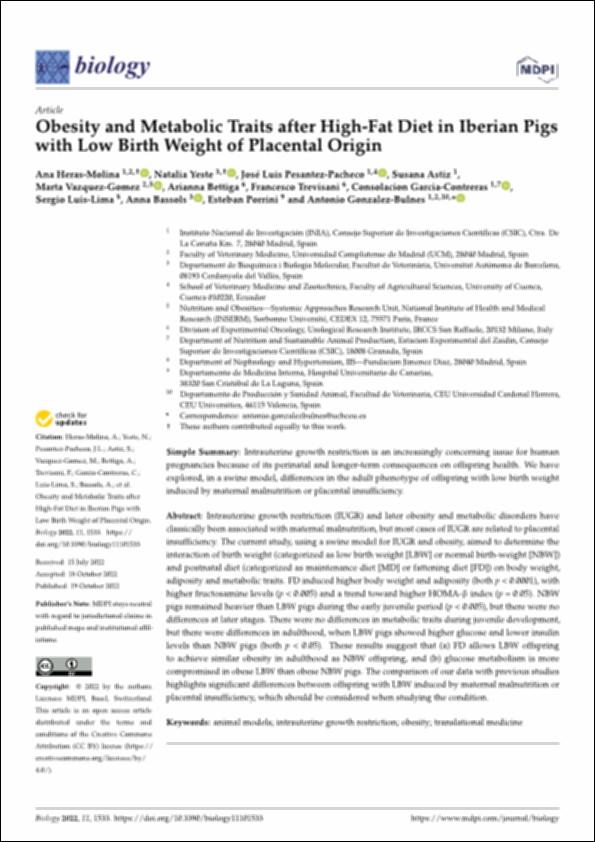Por favor, use este identificador para citar o enlazar este ítem:
http://hdl.handle.net/10637/14279Obesity and metabolic traits after high-fat diet in Iberian pigs with low birth weight of placental origin
| Título : | Obesity and metabolic traits after high-fat diet in Iberian pigs with low birth weight of placental origin |
| Autor : | Heras Molina, Ana Yeste Vizcaino, Natalia Pesántez Pacheco, José Luis Astiz Blanco, Susana Vázquez Gómez, Marta Bettiga, Arianna González de Bulnes López, Antonio |
| Materias: | Obesity in swine.; Lípidos - Metabolismo - Trastornos.; Obesidad en cerdos.; Lipids - Metabolism - Disorders.; Lipids in nutrition.; Cerdos - Alimentación.; Swine - Feeding and feeds.; Aceites y grasas en nutrición. |
| Editorial : | MDPI |
| Citación : | Heras-Molina, A., Yeste, N., Pesantez-Pacheco, J. L., Astiz, S., Vazquez-Gomez, M., Bettiga, A., Trevisani, F., Garcia-Contreras, C., Luis-Lima, S., Bassols, A., Porrini, E., & Gonzalez-Bulnes, A. (2022). Obesity and metabolic traits after high-fat diet in Iberian pigs with low birth weight of placental origin. Biology, vol. 11, i. 10 (19 oct.), art. 1533. DOI: https://doi.org/10.3390/biology11101533 |
| Resumen : | Intrauterine growth restriction (IUGR) and later obesity and metabolic disorders have classically been associated with maternal malnutrition, but most cases of IUGR are related to placental insufficiency. The current study, using a swine model for IUGR and obesity, aimed to determine the interaction of birth weight (categorized as low birth weight [LBW] or normal birth-weight [NBW]) and postnatal diet (categorized as maintenance diet [MD] or fattening diet [FD]) on body weight, adiposity and metabolic traits. FD induced higher body weight and adiposity (both p < 0.0001), with higher fructosamine levels (p < 0.005) and a trend toward higher HOMA- index (p = 0.05). NBW pigs remained heavier than LBW pigs during the early juvenile period (p < 0.005), but there were no differences at later stages. There were no differences in metabolic traits during juvenile development, but there were differences in adulthood, when LBW pigs showed higher glucose and lower insulin levels than NBW pigs (both p < 0.05). These results suggest that (a) FD allows LBW offspring to achieve similar obesity in adulthood as NBW offspring, and (b) glucose metabolism is more compromised in obese LBW than obese NBW pigs. The comparison of our data with previous studies highlights significant differences between offspring with LBW induced by maternal malnutrition or placental insufficiency, which should be considered when studying the condition. |
| Descripción : | Este artículo se encuentra disponible en la siguiente URL: https://www.mdpi.com/2079-7737/11/10/1533 En este artículo de investigación también participan: Francesco Trevisani, Consolacion García-Contreras, Sergio Luis-Lima, Anna Bassols y Esteban Porrini. |
| URI : | http://hdl.handle.net/10637/14279 |
| Derechos: | http://creativecommons.org/licenses/by/4.0/deed.es |
| ISSN : | 2079-7737 (Electrónico) |
| Idioma: | es |
| Fecha de publicación : | 19-oct-2022 |
| Centro : | Universidad Cardenal Herrera-CEU |
| Aparece en las colecciones: | Dpto. Producción y Sanidad Animal, Salud Pública Veterinaria y Ciencia y Tecnología de los Alimentos |
Los ítems de DSpace están protegidos por copyright, con todos los derechos reservados, a menos que se indique lo contrario.


